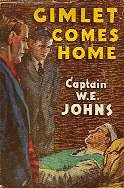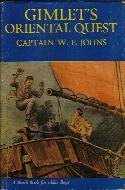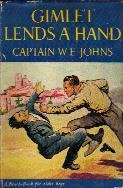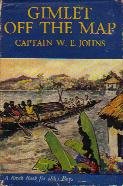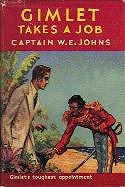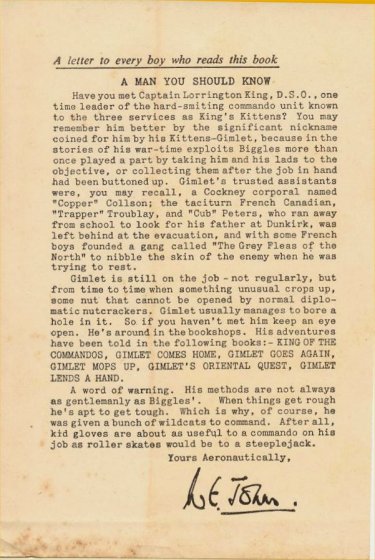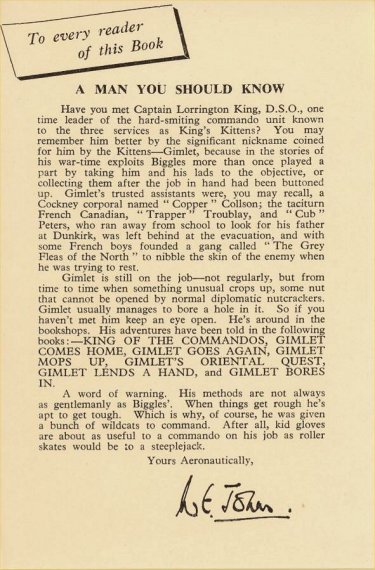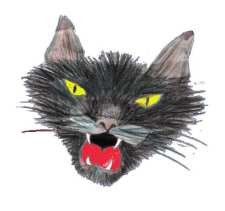| bc | Gimlet King by W E Johns, Gimlet, King of the Commandos. Danger – This Character Comes with A Special Warning.
A casual browser amongst the old Biggles books of the late forties and early 1950's might occasionally stumble across some rather odd promotional material for a new character called Gimlet. W.E.Johns promised that he would be tough and so would be the men that he commanded. Gimlet was a man chosen to hit back hard at the enemy, to use methods that might upset the squeamish and to ruthlessly push aside all thoughts of anything but the missions he was asked to accomplish. In the first two adventures "King of the Commandos" and "Gimlet Goes Again" the author certainly kept his word. Perhaps more remarkably the toughness did not fade with the passage of time and the move into the post-war environment. You can still see now the key words on the dust jackets of the Brock Books. "For older boys", it says, and how important that guideline is when you consider their possible effect on young minds of some quite brutal action and shocking scenes. Both Biggles and Gimlet may be gentlemen by birth and background (and we are told that both come from military families) but there the resemblance ends. There is no courtesy or chivalry in Gimlet's treatment of the enemy. There is no warmth in the humour to be found in any of the books; it is bitter, sarcastic and sometimes rather crude wit that emerges. As Copper remarks, "That'll stop him laughing in church" as another German tumbles to the ground. And yet, an often forgotten fact about Gimlet is that he too passed part of his military life as a pilot. He was involved in a collision with a German during the Battle of Britain and had previously shot down two German planes on one day after leaping into his aeroplane in his tennis flannels. In other words, as one of the famous "few" that Churchill said we owed so much to, his pedigree as a fighting man was immaculate even before we see him in action in "King of the Commandos." But let us return to Gimlet's creation. W.E.Johns was asked by the War Office to invent a soldier hero. His previous efforts with Biggles and later Worrals would naturally draw his teenage readers towards the "glamour" of service in the R.A.F. The mere thrill of flying was already half the battle won. How could he help to sell the idea of the footslogging infantryman in the face of such competition ? There seem to be basically three methods that he adopted. First of all he chose to write about the elite force that became the pinnacle of soldiering – the commandos. These were soldiers but no ordinary soldiers. Secondly, in the first two books there is an apparent determination to recreate the speed of movement through the air that the reader gets in Biggles books by the rapidity and variety of the means of transport that are used by Gimlet and his men on the ground. Thirdly, and most importantly, he assembled a team of men, whose distinct personalities would attract and hold the attention of his audience. Whereas Biggles' team of comrades developed over 25 years with Algy, Ginger and Bertie each joining the central hero at different, widely separated points in his life, W.E.Johns puts together the Gimlet team in the first book and introduces them all within the first thirty pages. With the exception of Trapper, who does not appear in "Gimlet's Oriental Quest" they stay together for the rest of their exploits. It is time to look more closely at these interesting creations: Corporal Albert Edward Collson or "Copper" The spirit of the capital city lives through Copper. He is big, determined, resilient and can certainly "dish it out" as well as take it. He is a Cockney and is the first to admit that he has been brought up "rough". The author remarks that he never talks about his difficult upbringing where he has been the main breadwinner of the family since his father died when he was a boy. A life of crime beckoned when, under the supervision of an uncle, he became proficient in picking locks of all kinds. Fortunately for Copper his uncle was caught and sentenced to five years. This led the young Copper to consider working on the other side of the fence and he joined the police force as an errand boy. As he grew in stature and experience he made big advances in both the force and in the boxing ring. Twice heavyweight champion of London he is a man with remarkable strength and specially trained skill in using it. In the ring, with boxing gloves, this six foot two dreadnought must have been a formidable figure; outside, with his bare fists, Copper is a killer. Throughout the stories there are descriptions of the remarkable power of his punches. The impact of his blows is "sickening" and the recipients usually lose consciousness after briefly traveling through the air after a devastating uppercut. The arrival of the war and the pulverizing of London under the German blitz turned the war into a personal affair for him. As his home crumbled to dust from the onslaught of the Luftwaffe, he applied for a transfer to one of the first commando units ever set up. His old mother survived the destruction of their humble house and, true to her Cockney spirit, moved in with a neighbour rather than leave the city she loved. Her emotional hold over Copper is strong, for he measures each extraordinary situation he gets in to by wondering what his old mother would say about it. A running joke about the length of Copper's hair, even after he is no longer under Gimlet's military command, is the one concession to humour that W.E.Johns makes amongst the comrades. When in "Gimlet's Oriental Quest" he complains that he only had it cut the previous week and that his mother liked it at that length, Gimlet replies, "Mothers always do," said Gimlet, smiling. "But you're a big boy now, and old enough to please yourself. Get-it-cut." Thus Copper pleases himself by obeying Gimlet's orders! Throughout the stories there are many instances of Copper being the proponent of direct action as the solution to each particular problem. On rare occasions his argument is accepted but, more often, Gimlet reins him in by pointing out that the law would object to his brutal methods or Cub points out how a ruse would succeed where heavy-handed tactics would fail. The wisdom of their advice is demonstrated in "Gimlet Comes Home" where Copper barges in on the villains but is knocked cold by an extra hidden enemy. W.E.Johns sums Copper up as a simple man but no fool. Trained in police methods, he can even recall faces from a wanted poster that he saw several years earlier. He has truly earned the name of Copper. Gimlet If Copper is copper, then Gimlet is steel. The dictionary definition of a gimlet is "a small boring tool with a worm or a screw for penetrating wood." Naturally he lives up to this nickname by always drilling his way to the centre of the problem. Inevitably one of the later stories is "Gimlet Bores In". Gimlet is, as Copper puts it, "a pukker sarb" (pukka sahib) a member of the upper classes. His full name is Captain Lorrington King, D.S.O., M.C. and Bar, of Lorrington Castle, Devon. He served in the Guards Regiment before the war, had a brief spell in the R.A.F. and is now the leader of King's Kittens, a special squad of commandos. Cub's first impression of Gimlet plays down any idea of a heroic appearance. After hearing about their formidable leader from Copper and Trapper, Cub confesses to feeling slightly disappointed when confronted by Gimlet for the first time in daylight. First of all Gimlet is much younger than he had anticipated – a mere twenty-five years of age. He is thin and handsome with close-cropped auburn hair. The most interesting features of Captain King are his eyes. Soft-blue and yet steely, they really did cut into Cub like a gimlet. His voice is quiet and he speaks with an Oxford accent. He clearly belongs to the same social set as Lord Bertie Lissie, though there are no "silly ass" expressions to emphasise the "lah-di-dah" idiocy of the English upper classes. We learn that his father and grandfather had both been V.C.s and that he has the habit of command. Most remarkable about Gimlet is his will-power and sense of purpose. Like Copper he too is a believer in direct action but, whereas Copper is like a particularly blunt instrument, a wide-sweeping bludgeon, Gimlet's cold steel is always sharply pointed and rapidly delivered to the vulnerable point of the enemy. Private "Trapper" Troublay If Gimlet and Copper represent the upper class and the working class mucking in together to defeat the much-detested Germans, then enlisting Trapper, a French-Canadian, into King's Kittens, is W.E.Johns' means of drawing the Empire into the war effort. News of Nazi atrocities has brought him from the backwoods of his native land to confront the enemy in Europe. He comes particularly well-qualified to join such an unusual and elite outfit. He also gives W.E.Johns lots of other possible ways of diversifying the storyline. The natural reserve of the Britisher about foreigners, which we would expect to find in Copper, is broken down by his reaction to Trapper. Not only does he come to tolerate Trapper as an efficient fighting man, he also adopts him as his special mate. Just like "Thirty" and "Rip" in "Biggles – the Rescue Flight" Copper and Trapper are prepared to go through "thick and thin" together. W.E.Johns thus demonstrates that it isn't only English public school boys that can show the comradeship and loyalty that binds a fighting force together. Ordinary working men and men from other countries can all do their bit if they bond successfully into a team. Doubtless the author was aware of the propaganda point that he was making but that doesn't mean that Trapper was merely there to make up the numbers. His colourful language with "Mot de Cambronne" and other French ejaculations are often used to highlight and underline Copper's more down-to-earth Cockney repartee. Above everything else Trapper is a man who is at home in the wild places of the countryside, whether they be the woods of France or the Highlands of Scotland or the jungles of Central America. He can track and trail and live off the land. His marksmanship is impeccable. His agility is demonstrated time and again as he shins up telegraph poles to cut communications or climbs up trees to make reconnaissances. Two other features make Trapper's contribution to the stories of vital interest. First there is a barely suppressed ruthlessness, learned from his Native American Indian friends, that has to be kept in check by Gimlet's cold commands. Trapper constantly hints that he knows ways of torture that would make dumb men talk. In "Gimlet Comes Home" he takes the opportunity to prove it, though W.E.Johns is careful to make it clear he has only done so after the enemy tried similar brutal tactics on Copper. With some enemies, like Nazis and gangsters, W.E.Johns is suggesting that any methods, no matter how inhuman, are justified. They are mostly not resorted to but their mere suggestion makes the veneer of civilisation that separates the commandos from their foes very thin indeed. These are certainly books for older boys. In a war where technology is often the deciding factor W.E.Johns succeeds in stripping back the conflict in the Gimlet books to the human factor. Thus Trapper's use of a bow and arrow is another master stroke that stays in the imagination of the readers long after the actual details of the incidents are forgotten. The echoes of Robin Hood are allowed to permeate the exploits of Gimlet and the kittens as they dodge the Nazi overlords and hide in the forests of Northern France. There is even a castle at Chateaudun that has to be stormed in the dead of night. Trapper, of course, has to fire the arrow through the narrowest of slits. Mostly, however, the arrow in the back is used for the silent disposal of unfortunate sentries who never know what hits them. Trapper is both handsome and fearsome. A bear had slashed open his face and left a livid scar on what would otherwise have been attractive features. He has a trace of a small black moustache on his upper lip and he occasionally grunts or clicks his tongue as a substitute for speech in times of extreme emotion. Inevitably, as the commandos move across the ground in hostile territory, Trapper is the one sent ahead to do the scouting. Nigel Norman Peters or "Cub" Though Gimlet is the titular leader of the commandos, it is Cub who is often the most important character in the series. It is mostly from his point of view that the stories are told. Gimlet is without weaknesses and, apart from a few minor worries about Cub on occasions, appears not to have a softer or human side. As the youngest of the characters in the stories, a mere fifteen when stranded in France, and nearly seventeen at the start of "King of the Commandos", Cub is the closest in age to the teenage readers. He is also that attractive personality – the schoolboy who ran away to war. What's more – Cub, for all his youth, makes it as a successful combatant on the field of battle. His father is an officer and he himself attends a public school, Brendall's on the Essex marshes. Swept up with the excitement of Dunkirk, Cub finds himself trapped in enemy occupied France. The reader learns of his struggle for survival and his eventual teaming up with Louis Morelle and the foundation of the Grey Fleas of the North. Once again W.E.Johns delivers a message that could not be clearer about the contributions that can be made to the war effort. Firstly, even young people can fight back against the evil of the Nazis; they can be particularly effective when they team up with professionals like the commandos. Secondly, the young people of France have formed their own kind of resistance that makes the Allies' efforts to free their country a worthwhile objective. That they do so with cheek and with daring is an extra bonus. Two years of living on very little food and on most of the time on his nerves have left marks on Cub's face that make him appear older than his years. Like his companions his marksmanship is outstanding and he carries a small Mauser automatic that, though small, packs a deadly punch. Whilst the story of his life in France is remarkable, W.E.Johns spends more time emphasising how impressed Cub is with the achievements of his new comrades, the commandos. From the beginning of their acquaintance he is fascinated by Copper and Trapper whom he regards as "genuine but unusual" men. In spite of his years, nevertheless, it is he who takes command when Gimlet is not around. Firstly, in France, because he knows the territory and the people so much better than they do and later in other adventures because he can use his natural wits and his instinct for deduction. In wartime he shared a common quest with these extraordinary soldiers, in peacetime he too finds it hard to adjust to an ordinary lifestyle. The author makes it clear that war has robbed him of his youth and his innocence. For one so young Cub accepts death and the handling of dead bodies in "Gimlet Goes Again" and "Gimlet's Oriental Quest" in a way that makes it clear that he has become hardened, though not insensitive. That final point about his sensitivity is well worth making, for in stories such as "Gimlet's Oriental Quest" and "Gimlet Lends a Hand" it is his sympathetic understanding of the suffering of a son who has lost his father and then a father who has lost his son that draws him into danger for purely unselfish reasons. It is no surprise that when Biggles' group teams up with Gimlet's band for a particular enterprise such as in "Biggles Follows On ", Bertie may chat with "Lorry" King whilst Cub finds himself alongside Ginger, himself once the young person's perspective. Kings' Kittens or Different Cats ? The cat metaphor is well worth exploring for different facets of it sum up well the various qualities of Gimlet's team. Without doubt Gimlet is the leader of the pack, the king lion who organises the attacks on the unsuspecting herds of buffalo. He gives the signals; he stands at times, rampant and defiant. Copper is the strength of the lion, the brutal ferocity that can tear the victims to pieces. Trapper has all the cunning of the tiger in concealment and the stealth of movement of the wildcat. Whether Cub was meant to be the fox cub, the bear cub or the lion cub, though but partly grown, he is small but deadly, using tricks and disguises until the pack is there in full strength to support him. To give away the plot of a book is perhaps the dirtiest trick that a reviewer can pull. Therefore in the accounts that follow some ingredients will be revealed but enough will be left unsaid for readers to find out lots more for themselves. "King of the Commandos" The double meaning of the title must surely be a deliberate ploy. It isn't just Gimlet's name but Gimlet's status that is being hinted at. In a special fighting force the C.O. of the kittens is an even more special man. The story starts in the thick of the action of a commando raid, takes a brief rest whilst the original team plus Cub return to England, and then accelerates its way on a special new raid across Northern France. We meet for the first time "Les Poux Gris du Nord" and learn about their acts of both cheeky and dangerous sabotage against the German war effort. No sooner have we met them than we learn their leader is to be shot in the town centre of Caen. If the British commandos were surprised at the extent of the young French boys' network and their sophisticated systems of intelligence, then Cub is both thrilled and horrified at the ruthless efficiency of the commandos. Gimlet's attitude to his job is so outrageously simple that the shortest route between two points really does seem to be a straight line even when Germans are standing in the way. Boys love to play with train sets and so W.E.Johns lets Gimlet, Copper, Trapper and Cub loose on the French rail network with alarming results. Everyone also knows that boys love to stage train wrecks and these "boys" are no exception. Like Lord Bertie Lissie does in "Biggles Fails to Return", Gimlet comes across an old adversary of his pre-war years of motor racing on the continent, and they use one of the old tricks to defeat the Germans. A courageous young French girl, a patriotic priest and a Vichy traitor all have their parts of play before Cub can draw a peaceful breath again back in England where good news is waiting for him. "Gimlet Goes Again" As the title suggests W.E.Johns gives you more of the same. Another raid into Northern France, this time by parachute, leads Gimlet and Cub and later Copper and Trapper into dangerous waters once again. The atmosphere of this book is darker, though the exhilaration of movement sweeps you along in the second half. "Just whom can you trust" is apparently the theme of much of this book in which characters from the Gestapo and the British Secret Service both adopt intriguing and alarming new identities. Cub is even reduced to wondering if anyone in France is what he seems to be. A nightmare rail journey from Caen to Paris is just one of the highlights in this story where, for the first time the official French Resistance takes a dramatic part in the proceedings. The scheme dreamed up in the final section of the book is so amazing and uplifting that it would rob the story of its special appeal to give you any details. That it involves both bicycles and Biggles should be enough for any real fans to want to read it for themselves. Inevitably lots of Germans are disposed of but the commandos themselves are appalled by what they have come through. "Blimy ! Talk about falling backwards through
'ell," muttered Copper, "If my old Ma –
"
Real Second World War commandos trained in the wilds of the Scottish hills and lochs and so this team, led by Cub, soon adjust themselves to their wild surroundings and a new enemy, just as ruthless and deadly as the Germans. Trapper's backwoodsman's skills prove invaluable on the remote Invercarglass Estate but Copper blunders badly and ends up in extreme danger. The threat is all too real and too horrible as Slim Delano pulls out his narrow-bladed stiletto and whets it on the palm of his left hand. "See this ?" he enquired. The former King's kittens fight back and, though partially restrained by the laws of peacetime, show the fierceness of their jaws and claws to all who meddle with them. "Gimlet Mops Up" The war may be over but the German Werewolves are determined to fight on. Their targets are the soldiers, sailors, airmen and intelligence officers who helped the Allies to rout their armies and bring to an end their hated Reich. Unable to get a toehold in Germany itself, the Werewolves have managed to smuggle themselves into liberated countries and indeed into Britain itself. And Gimlet is on their list for trial and execution ! Freed once again from the constraints of peacetime laws and restrictions, Gimlet and his men are commissioned to root out the enemy and destroy it. The appeal of the story is enhanced by the interesting variety of locations that are used. The reader rides along with Cub on a breakneck fox hunt where the fox is not the quarry. He visits the church of a peculiar sect in the East End of London which has a secret bolthole into the sewers that empty into the Thames. For the second adventure running Gimlet is captured by the enemy and, once again, Cub, Copper and Trapper pull him back to life at the last second. Finally there is a commando raid with a difference – this time in the quiet backwater of the English countryside. The cooperation of the Air-Police ensures that Biggles and Ginger join in to track the wolves to their lair.
This is a treasure hunt with a difference. It leads by way of a private yacht to a teahouse, next to an opium den and then on to an island in an artificial lake. There is a villain who is both suave and sadistic. There are the perils of wild animals and diseased-ravaged natives. Cub and Tony face the prospect of the torturer's metal heated in a red-hot brazier. As Tuanik says of his henchmen, "They boast that they can make the dead speak." A ghastly death awaits some of the travellers to Kashan's estate. By the end of the story both Cub and Gimlet are forced to agree with Copper that the animals they encounter would be more reassuring locked up in a zoo. "What else 'ave you got in this perishin' Whipsnade ?" says the big Cockney as a herd of elephant crash across their path. He is soon to find out…..
Copper echoes some of the feelings that Biggles occasionally expresses about the people higher up. Even Cub and his father have given up running their farm because they too are swamped with forms. The mood soon changes when Cub gets a dangerous job, one that he is uniquely qualified for. The rest of the book is set in the French mountain-top town of Vallonceau in Provence. Without doubt W.E.Johns' evocation of this extraordinary setting, with its medieval and Roman past brooding over the doings of the present-day people, is a tremendous success and gives the book that special atmosphere that marks it out from the others. Cub's mission grows increasingly dangerous as he
uncovers the villains and they simultaneously work out
his real purpose. Never before had he realised just how
much he depended on Gimlet. "Tonight, if they start something, it'll be interesting to see how they behave when they find the stuff they're so fond of dishing out, coming back at them."
Once again, like in "Gimlet's Oriental Quest", the team of Gimlet, Cub, Copper and Trapper, have just as much trouble with the jungle animals as they do with their human adversaries. Trapper finds the trails, Copper frightens a ghost and Cub has to face a Harold at Hastings situation, where the dropping arrows at any moment could plunge into his eye but are too horribly fascinating to ignore. Besides that the arrow tips are poisoned. A mere scratch could end it all. Towards the end of the book the river rises rapidly and so does the excitement. "Gimlet Bores In" Once more Biggles flies east and delivers the commando team for another raid into a hostile country. It is the Caucasus Mountains that are the destination after making a clandestine landing on the waters of the Black Sea. It's a political job that they have undertaken even though none of them want any truck with politics. A man has been taken prisoner and it is Gimlet's job to rescue him. As Copper puts it they need have little concern about taking on the enemies that confront them for "They must be a lot of rats ter put a bloke in quod for 'avin an opinion of 'is own." Just how vicious life is in the shadow of the Caucasus Mountains is revealed on the second day of their expedition. As they lurk in the trees near a small hovel of a dwelling, the comrades witness a brutal atrocity carried out by some soldiers. A poor peasant is shot down in front of his family and the wretched place they called home is set on fire. Copper has to be restrained by Gimlet from intervening. This ghastly episode sets the tone for a very brutal book. Without doubt W.E.Johns wanted to convince his readers of the horrors of Communism and the suffering of the people who lived under it. He pulls no punches, for later Cub, hidden by the roadside, stares in wonder at some derrick-like constructions, puzzling over their significance and the meaning of the bundle of clothes that was suspended in the air. "..quite slowly, he realised what he was in fact looking at, the colour drained from his face and his mouth went dry. The clothes it is true, were there. So was the man to whom they belonged. He was inside them, hanging by the neck." Nowhere in the Gimlet stories does W.E.Johns' warning that these books are rougher and tougher than the Biggles adventures seem more appropriate. The extraordinary characters – including a wild half-Scottish brigand, and the extraordinary setting, with a remarkable castle fortress and its double-crossing commandant, both combine to make this story one of the darker tales produced by this author. The stratagems practised by Biggles to evade the patrolling enemy ships and rendezvous with the flimsy dinghy ingeniously bring this "tale for older boys" to an end.
It may seem to be a story of the bad old days of the British Empire fighting the possible incursion of Communism. However, W.E.Johns actually makes it work as a story which shows the resilience of a native people who have been terrorised by a combination of brute force, forced drug usage and voodoo magic. It isn't just the black population that have fallen to the devious and cruel tactics of the villains; the previous white administrations have been outwitted, tricked and subjugated by the powerful forces of evil let loose on the island. Even Copper falls a victim to the spell of a powerful hypnotist, though he forever denies it ! Gimlet's will power is tested to its uttermost in this, the last of the adventures of the special team. "Comrades in Arms" – "An Oriental Assignment" In this Second World War book which also contains a Biggles story and a Worrals story, Gimlet's adventure is actually the longest. It tells of yet another raid into a country where one of the principal languages is French and which is occupied by the enemy. This time it is Vietnam and the enemy are the Japanese. The quest is for some seeds of a special hybrid rubber plant that have been placed inside an ornamental elephant in the Orient Hotel in Saigon. All Cub, Trapper and Gimlet have to do is stroll in and collect them. Copper is left behind with the stores because he can not speak French. It seems a simple enough job, but, naturally, things pretty quickly start to go wrong and many near-misses take place before the comrades are once again scooped to safety by Biggles. "Biggles Follows On" When a man is needed to destroy an enemy broadcasting station and to release some prisoners Biggles knows who to turn to. Gimlet and his comrades help to complete this adventure in their usual fashion. Your Chance to Help Out "Gimlet Gets the Answer" This is a bit of a mystery book. Very few copies seem to exist and it is difficult getting hold of one. It has never been published in a paperback version. The story is set on Cyprus and there is a villain called Knifey. One finally came into my hands a few weeks ago and, with a little bit of detective work, I think I have found the reason why it is so scarce. My first theory about why it had never made it to paperback was that during the 1950's Cyprus became a hotbed of political unrest. Greek terrorists wanting Enosis (union with Greece) were busy taking action against the British. Perhaps W.E.Johns stumbled unwittingly into a minefield of Foreign Office prohibitions. A quick read of "Gimlet Gets the Answer" soon blows this idea out of the water. The villains are American gangsters and their racket is….. No, I can't tell you - for that would be giving away the central plank of the plot. However, nothing about Cypriots or terrorists or freedom fighters comes into the plot. My second thoughts about this rare book were that, like some of the later Biggles books, it simply didn't possess enough merit to be worth republishing. This may be partly true. It certainly isn't as strong as the others close to it in the series but it is still a fascinating read with some good descriptions of the Cyprus countryside. I suspect that the real reason is far sadder and really quite eerie. One of the principal events at the end of the book is an earthquake and Gimlet, Copper, Trapper and Cub witness some devastating destruction. Cyprus has always been part of an earthquake zone, lying at the edge of the Arabian tectonic plate. However, though minor disturbances had taken place during other years in the 20th century, when "Gimlet Gets the Answer" was published in 1952, no major events had taken place for some time. Unhappily, in the following year, in September 1953, a significant earthquake took place near Paphos which resulted in 63 deaths and over 200 injured. In the circumstances republishing such an adventure story was probably not an option. All this is still theory, which is why I would welcome the help of anyone who knows any more about "Gimlet Gets the Answer". [A note from the editor. The later Hampton editions dispensed with the blue borders on the jackets and showed the illustrations uncropped. Thanks to Greg for the loan of his paperbacks.] One-sheet promotional inserts
|
bc |
